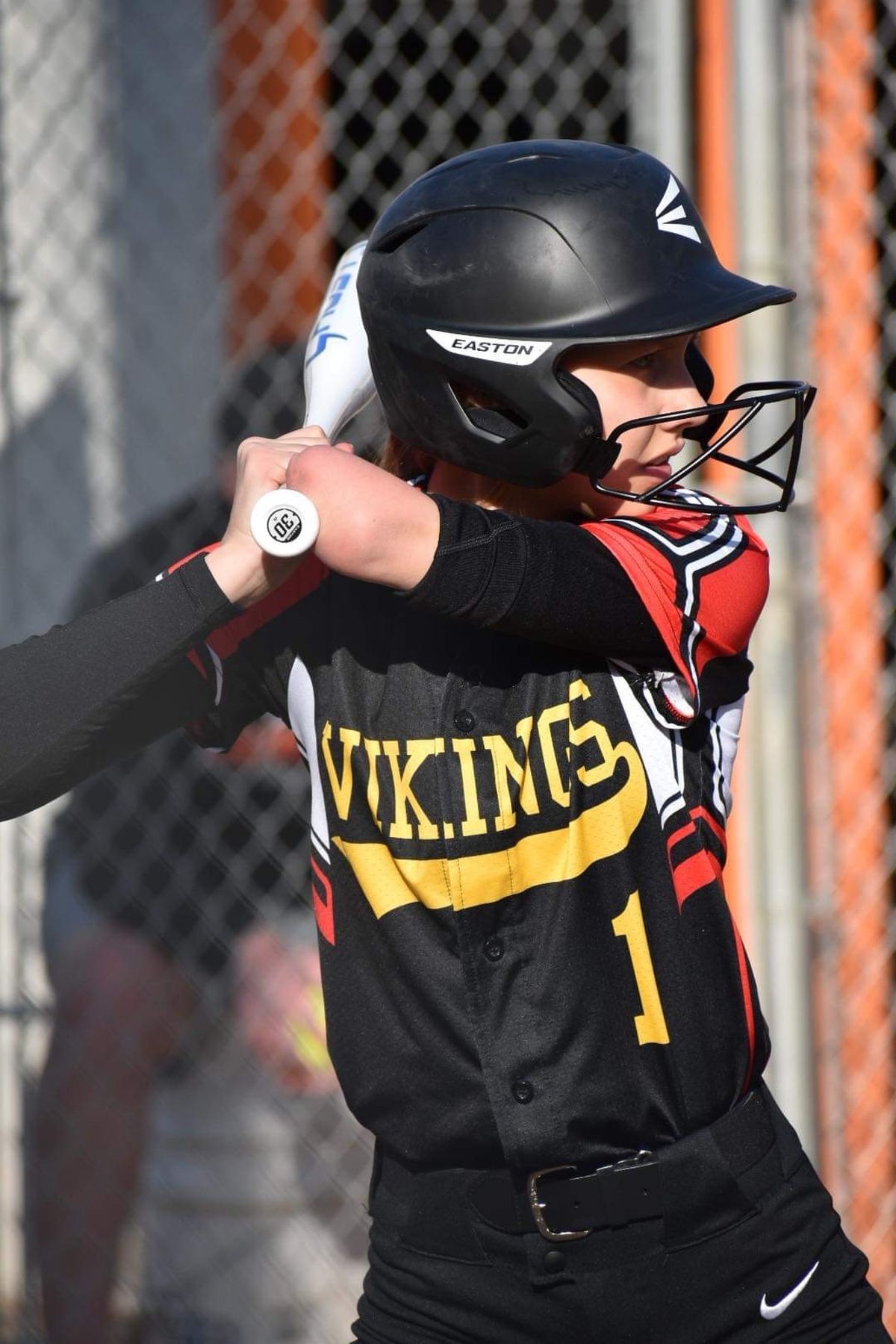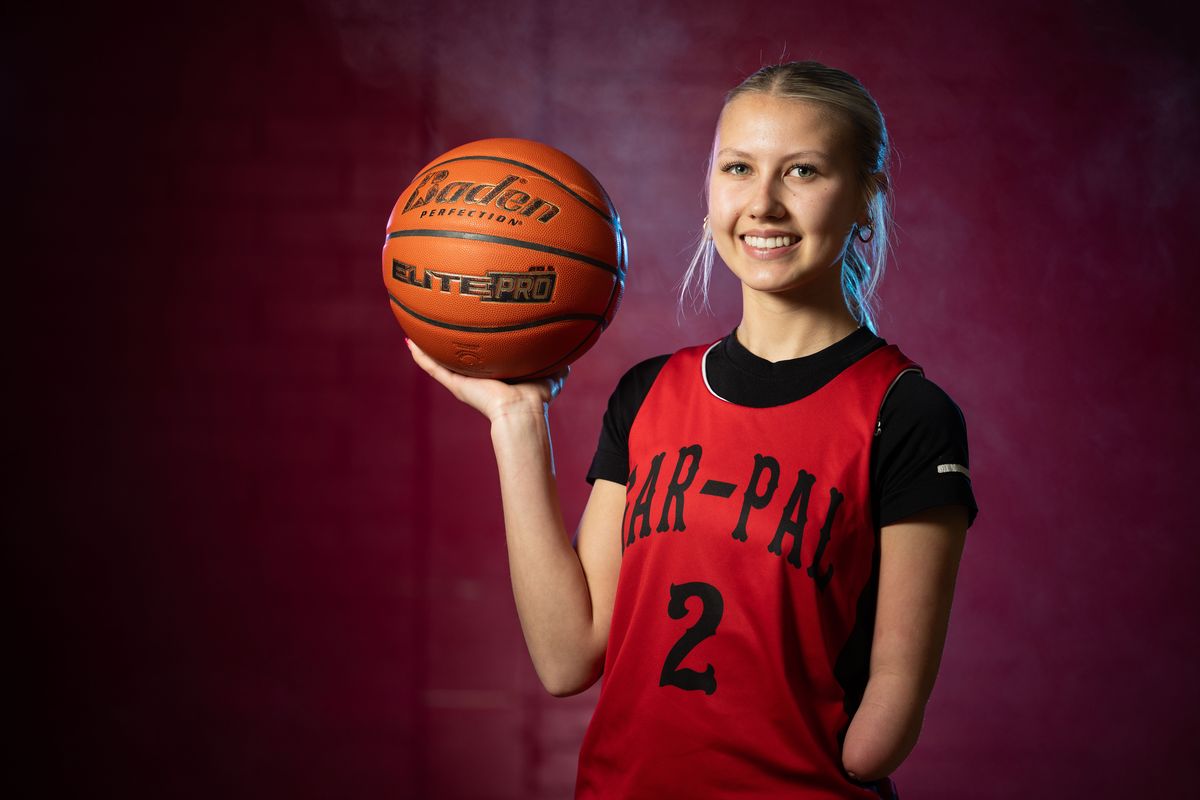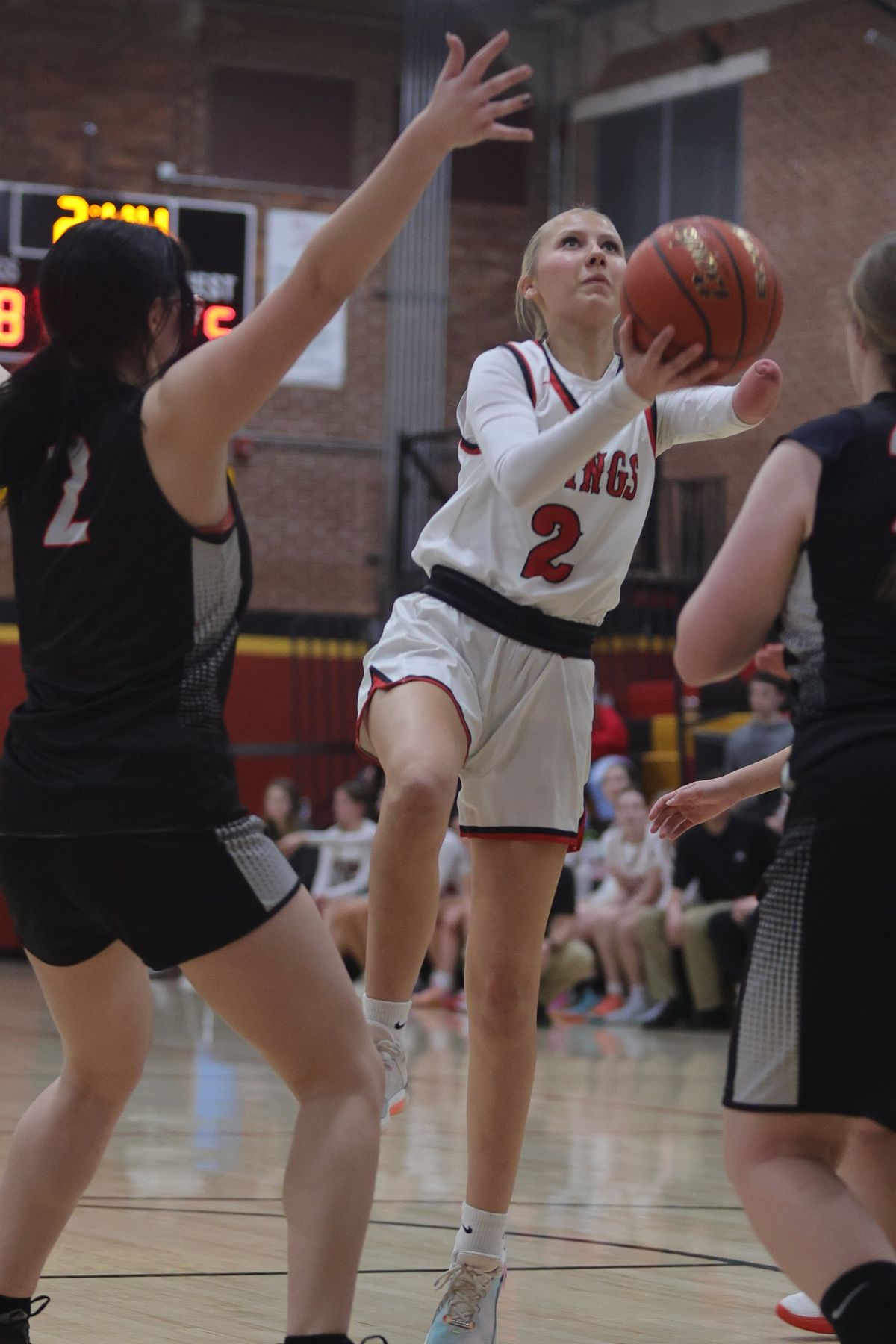‘Nothing she can’t do’: Born with one hand, Garfield-Palouse’s Kaydence Kivi thrives on basketball court
Garfield-Palouse sophomore Kaydence Kivi was born with one hand as a result of amniotic band syndrome. The Vikings play at the State 1B tournament at the Arena this week. (Colin Mulvany/The Spokesman-Review)
Kaydence Kivi grew up playing any sport she could. Basketball, volleyball, gymnastics, softball, soccer – you name it, she tried it. Now in high school, the 5-foot-6 sophomore is a key player on the Garfield-Palouse girls basketball team seeded third in the State 1B tournament this week at the Arena.
“She’s a go-getter. She’s our energy,” Gar-Pal coach Garrett Parrish said last week at practice. “There’s nothing she can’t do.”
That’s a high compliment from a coach. It’s even more profound considering Kivi only has one hand.
“They didn’t know I had one hand until I came out,” Kivi said. “I was just born with it.”
“I’ve coached her since she was in sixth grade,” Parrish said. “I don’t even think about it. She’s just one of them, you know? It’s a cool story, and it’s great for other kids to see that are in the same situation. … But when she’s in this gym, she’s just another player.”
Born this way
Kivi suffered from a rare congenital disorder called amniotic band syndrome while in the womb. ABS occurs when thin, fibrous bands of tissue separate from the inner lining of the amniotic sac and become entangled around the developing fetus. These bands can restrict blood flow and growth, leading to a variety of birth defects. The incidence of amniotic band syndrome is 1 out of every 1,200 to 15,000 live births.
Those bands effectively amputated Kivi’s left arm just below the elbow before she was born.
“We had no idea about it until she was born. They usually catch it on a scan, but they missed it,” Kaydence’s mother, Tammy, said. “But we learned really fast she wasn’t going to have any limitations.”
The condition is natural to Kivi, and it has to be – she’s known nothing else. Her parents tried prosthetics for her as a child, but they came to realize Kaydence was better off without them.
“She showed us really quickly she wasn’t going to need those,” Tammy said. “The doctors said that kids that are born this way, made this way, they don’t know they are missing anything. They just adapt.”
“Growing up, I didn’t feel different,” Kaydence said. “Not until I started getting older, realizing that, ‘Oh, maybe I am a little different.’ But I did all the things that I felt every other normal kid did, like playing all the sports. I played everything, and I felt pretty normal.
“I never really questioned it. It’s just second nature.”
Her parents had initial reservations when Kaydence first showed interest in playing sports, but Kaydence’s effort and enthusiasm quickly assuaged their fears.
“We never held her back, for sure. But we did have doubts,” Tammy said. “It was like, ‘Oh gosh, how is she gonna play basketball? Or volleyball?’ ”
“We were concerned how things would work out,” Kaydence’s father, Andy, said. “But she adapted to everything.”
Andy recalled Kaydence’s first basketball game at 6 years old. On her first play she stole the ball and went the length of the floor for a layup.
“I looked at Tammy and said, ‘I think she’s gonna do just fine.’ ”
Occasionally, Kaydence will have a fleeting thought to wonder if she would be a better player with two hands, but she won’t let herself dwell on it. Since she started playing sports so young, she doesn’t remember a time when someone told her, “No. You can’t do that.”
She wouldn’t listen if they did.
“I don’t keep it in my mind. I try to push it back,” she said. “I try not to think about it, just because if I do start thinking about it, then I might start feeling bad about myself. Then I’m like, ‘Well, I can’t do anything about it.’ ”
“Nothing has ever stopped her,’ Andy said. “You can’t tell her, ‘No.’ She’ll prove you wrong.”
As she got older, and the competition got better, Kaydence gravitated more toward basketball and softball.
“A couple years ago, I quit volleyball. It was just a little bit harder, obviously, because you do need more of two hands for that sport.” she said.
“One reason I like basketball is my teammates and my team. I think that it would have been different if I was in a different atmosphere without them. They’ve always been supportive – everyone in the crowd, everyone on the team, off the team, everyone supporting me. It’s really helped.”
“We don’t cut her any slack,” Parrish said. “We don’t cut her any break and say, ‘Don’t do this.’ She has to jump in. And the expectations are the same for her as they are for everyone else. And she rises up to it.”
High hopes
Gar-Pal went 22-2 this season and 14-0 in the Southeast 1B League Wheat Division. The Vikings finished second in the league tournament to Yakima Nation Tribal, then beat Wilbur-Creston-Keller out of the Northeast 1B 71-40 in the District 6 crossover.
The Vikings qualified for state last year as a No. 12 seed and won a Round-of-12 game before being bounced in the fourth-place bracket.
“Last year, I don’t know if it was totally unexpected, but it was a fun trip,” Parrish said. “We knew this year we had it. We had almost everyone back, so the expectations were high, and I think we’ve done a good job living up to it.”
The hard work starts this week.
“There’s a lot of high hopes,” 6-1 junior guard Elena Flansburg said. “A lot of community members have come up to us and said, ‘You think you’re gonna go for the state championship this year?’ We’re like, ‘Well, we gotta make it through the first rounds of state.’ We’re just trying to go one step at a time.”
“I’m very proud of our team for getting this far,” Kivi said. “I know we have so many goals we still want to accomplish. We really want to at least place at state. It’s been years for our town, and it’s exciting to get this far. And our team, we couldn’t do it without all the support of everyone and our coaches – and especially our bond. … We love each other like family.”
That bond is a big part of what fuels the Vikings.
In a school of roughly 90 students, one-third of the girls who attend Gar-Pal play on the varsity basketball team.
“Our slogan this season is: ‘All together,’ ” Flansburg said. “Before practice, after practice, before our games – we’re always talking about how we’re in all of this together.”
It’s a young team, with just one senior. Five freshmen and an eighth-grader help fill out the roster.
“We’re young, but we also have quite a bit of experience,” Parrish said. “A few of them played as eighth-graders. So you know, our freshmen have a little more experience than most freshmen, and our juniors have been playing for a while.”
“It’s cool that the same girls I’m in class with are all on the team,” Flansburg said. “I’ve known them my entire life.”
Using her voice
Mature for her age, even though she’s still a sophomore, Kivi has taken on a leadership role on the young team.
“She’s vocal, which always helps,” Parrish said. “You know, people will listen to you if you speak up. And she has a voice. She speaks.”
Her condition lends her to being an inspirational figure among her teammates, but Kivi is not only that. Parrish describes her as a “terror” on defense and more than earns her playing time.
“I’ve had teams in the past where she would be out there starting,” he said. “This team is just really, really deep and really good.
“Maybe she doesn’t get quite as many minutes, but when she gets out there, we ask her to play hard on defense and get after whoever their ball handler is. And she does a really good job at that.”
Parrish said playing one-handed doesn’t limit Kivi in the least.
“She’s super quick. She’s got a great first step. She can finish around the rim, she can shoot, she can do it all.”
“I love having opportunities to play,” Kivi said. “It’s really cool, especially when I do something that someone wouldn’t expect me to do – like, go left, or something. They’re always like, ‘Oh my gosh, you can do that.’ And I love it, especially inspiring other kids who are the same as me.”
Kivi hadn’t heard of Jim Abbott, the former MLB pitcher who was born without a right hand. But she loves the idea of being a role model for anyone that might see themselves in her.
“There was girl who had lost her leg. I talked to her a little bit, and she said she loved watching me play,” Kivi said. “And she does basketball now, and I’m proud to watch her play as well and see her achievements.”
She draws inspiration from being an inspiration to others.
“It makes me feel more confident to play knowing that, yeah, I’m different, but if I’m helping other people feel confident then that makes me feel really good.”








